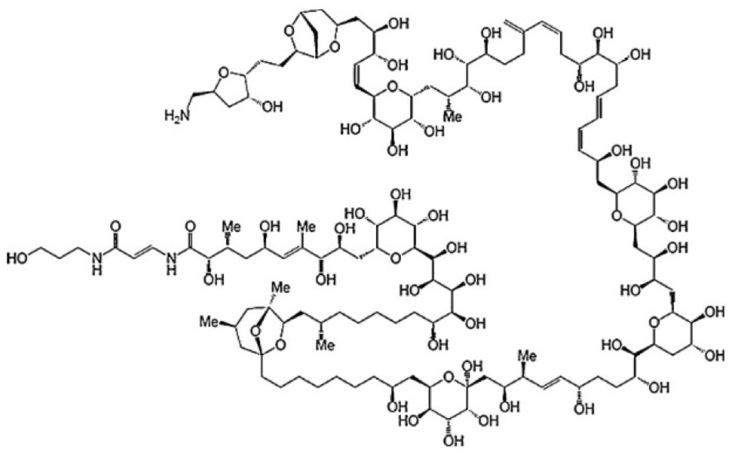Formula C129H223N3O54 | ||
 | ||
Appearance white amorphous hygroscopic solid | ||
Palytoxin is an intense vasoconstrictor, and is considered to be one of the most toxic non-protein substances known, second only to maitotoxin in terms of toxicity in mice. Palytoxin is a natural compound, (chemically a fatty alcohol) that is produced by several marine species and can be found in many more species due to a process known as biomagnification. Palytoxin was originally isolated in 1971 in Hawaii from the seaweed-like coral "limu-make-o-Hana" (Seaweed of Death from Hana). Later, in 1982 its full chemical structure was published by Prof. Daisuke Uemura and co-workers at Nagoya University. Yoshito Kishi's group at Harvard University first synthesized palytoxin in 1994. Palytoxin targets the sodium-potassium pump protein by locking it into a position where it allows passive transport of both sodium and potassium ions, thereby destroying the ion gradient that is essential for most cells. Because palytoxin affects every cell in the body, the symptoms are very different for the various routes of exposure. The most common exposure in humans is by ingestion or inhalation. The onset of symptoms is rapid, and death usually follows quickly.
Contents

Legend

According to an ancient Hawaiian legend, (Malo 1951) on the island of Maui near the harbour of Hana there was a village of fishermen haunted by a curse. Upon their return from the sea one of the fishermen went missing. One day, enraged by another loss, the fishermen assaulted a hunchbacked hermit deemed culprit of the town's misery. While ripping off the cloak from the hermit the villagers were shocked because they uncovered rows of sharp and triangular teeth within huge jaws. A shark god had been caught. It was clear that the missing villagers had been eaten by the god on their journeys to the sea. The men mercilessly tore the shark god into pieces, burned him and threw the ashes into a tide pool near the harbour of Hana. Shortly after, a thick brown moss started to grow on the walls of the tide pool causing instant death to victims hit by spears smeared with the moss. Thus was the evil of the demon. The moss growing in the cursed tide pool became known as "limu-make-o-Hana" which literally means "seaweed of death from Hana." The Hawaiians believed that an ill curse came over them if they tried to collect the deadly seaweed.
Discovery

Palytoxin was first isolated in 1971, by Moore and Scheuer. It was then assessed that the limu-make-o-Hana was not a seaweed but an animal, a soft coral (Walsh and Bowers 1971). The molecule responsible for its high toxicity was named palytoxin.
Total synthesis

Because palytoxin is such a large molecule, it took some time before the complete structure (including stereochemistry) was elucidated. In 1982, this problem was solved almost simultaneously by Moore and Hirata. Palytoxin's structure being established, it was synthesized in eight separate parts and then joined together to form the entire molecule. First, palytoxin carboxylic acid was synthesized in 1989 by the group of Harvard professor Yoshito Kishi, and in 1994 they succeeded in making palytoxin from this carboxylic acid. The accomplishment of this synthesis has been named "the Mount Everest of organic synthesis, the largest single molecule that anyone has ever even thought about making" by Crawford in 1989.
Incidents
A formerly unknown derivative of palytoxin, ovatoxin-a, produced as a marine aerosol by the tropical dinoflagellate Ostreopsis ovata caused hundreds of people in Genoa, Italy, to fall ill. In 2005 and 2006 enormous blooms of these algae occurred in the Mediterranean sea. All those affected needed hospitalization. Symptoms were high fever, coughs and wheezes.
Mechanism
The toxicity of palytoxin is due to its binding to Na+,K+-ATPase (sodium pump), where it interacts with the natural binding site of ouabain with very high affinity. Na+,K+-ATPase is a transmembranal protein, which is found on the surface of every vertebrate cell. Also, the sodium pump is necessary for viability of all cells, and this explains the fact that palytoxin affects all cells. Palytoxin is the first toxic compound found to cause formation of a channel. Through this channel, which it forms within the sodium pump, monovalent positive ions such as sodium and potassium can diffuse freely thereby destroying the ion gradient of the cell. Once palytoxin is bound to the pump, it flips constantly between open and normal conformations. The open conformation is more likely (>90% probability). If palytoxin disscociates, the pump will return to closed conformation. In open conformation, millions of ions diffuse through the pump per second, whereas only about one hundred ions are transported through a normal functioning transporter.
Because the mechanism of action of palytoxin was so unlike any other, it was initially not widely accepted. This was primarily because it was not expected that a pump which provides active transport, could become an ion channel by binding of a compound such as palytoxin. Therefore, there were some alternative hypotheses, which were reviewed by Frelin and van Renterghem in 1995. The breakthrough research which is seen as proof for the sodium pump mechanism was performed in yeast cells. These cells do not have the sodium pump, and hence palytoxin does not affect them. But once they were given the DNA to encode for complete sheep Na+,K+-ATPase, they were killed by palytoxin.
Toxicity
An early toxicological characterization classified palytoxin as "relatively non-toxic" after intragastric administration to rats. The lethal dose (LD50) was greater than 40 µg/kg. The LD50 after parenteral administration was lower than 1 µg/kg. However the doubtful purity of this study increased because of uncertainty concerning the toxicological data. In 1974, the structure of palytoxin was not completely elucidated and the molecular weight was a lot higher (3300 Da instead of 2681 Da). A 2004 study discovered an LD50 of 510 µg/kg after intragastric administration in mice, but histological or biochemical information was missing. (Rhodes and Munday, 2004) Furthermore, palytoxin was not lethal to mice given an oral dose of 200 µg/kg. It was also found that palytoxin is very toxic after intraperitoneal injection. The LD50 in mice was less than 1 µg/kg. Because toxin-producing organisms spread to temperate climates and palytoxin-contaminated shellfish were discovered in the Mediterranean Sea a study was done to better define the toxic effects of palytoxin after oral exposure in mice. Palytoxin was lethal from 600 µg/kg doses. The number of deaths were dose-dependent and the LD50 calculated to be 767 µg/kg. This is comparable to the LD50 of 510 µg/kg referred by Munday (2008). The toxicity was not different if the mice had some food in their stomach. The oral toxicity is several times lower than the intraperitoneal toxicity. One of the possible causes of this behavior is that palytoxin is a very big hydrophilic molecule and therefore the absorption could be less efficient through the gastrointestinal tract than through the peritoneum. A recent study by Fernandez et al further investigated on this issue using an in vitro model of intestinal permeability with differentiated monolayers of human colonic Caco-2 cells, confirming that palytoxin was unable to cross the intestinal barrier significantly, despite the damage the toxin exerted on cells and on the integrity of the monolayer. The same study also revealed that palytoxin does not affect tight-junctions on such cells. Palytoxin is most toxic after intravenous injection. The LD50 in mice is 0.045 µg/kg and in rats 0.089 µg/kg. In other mammals (rabbits, dogs, monkeys and guinea pigs) the LD50 is ranged between 0.025 and 0.45 µg/kg. They all died in several minutes to heart failure. The lethal dose for mice by the intra-tracheal route is above 2 µg/kg in 2 hours. Palytoxin is also very toxic after intramuscular or subcutaneous injection. No toxicity is found after intrarectal administration. Palytoxin is not lethal when topically applied to skin or eyes. There are cases where humans died after consumption of palytoxin. In the Philippines people died after eating Demania reynaudii, a crab species. After eating the sardine species Herklotsichthys quadrimaculatus some people died in Madagascar. Near fatal cases took place in Hawaii and Japan. In these cases people had eaten smoked fish and parrotfish respectively. There are also cases known that persons were poisoned by palytoxin through dermal absorption. Those people, in Germany and the USA, touched zoanthid corals in their aquariums at home. Another person was exposed to palytoxin via inhalation when he tried to kill a Palythoa in his aquarium with boiling water. Combining all animal studies, the toxic dose for humans was estimated to be between 2.3 and 31.5 µg palytoxin. An acute reference dose was suggested to be 64 µg for a person with weight of 60 kg.
There has been reported cases where individuals have been presumably poisoned from cleaning organisms containing palytoxin under steaming water. Precautions should be taken as the palytoxin can travel in water vapor and cause poisoning by inhalation.
In this context despite the increasing reports of palytoxin contaminated seafood in temperate waters (i.e., Mediterranean Sea), there are no validated and accepted protocols for the detection and quantification of this class of biomolecules. However, in the last years, many methodologies has been described with particular attention on the develop of new techniques for the ultrasensitive detection of palytoxin in real matrix such as mussels and microalgae (based on LC-MS-MS or immunoassay).
Symptoms
Palytoxin could be related to ciguatera seafood poisoning and thus give rise to a number of symptoms related to this poisoning. Clupeotoxism, poisoning after consuming clupeoid fish, is also suggested to be caused by palytoxin. Neurological and gastrointestinal disturbances are associated with clupeotoxism. The most common complication of palytoxin poisoning is rhabdomyolysis. This involves skeletal muscle breakdown and the leakage of intracellular contents into the blood plasma. Other symptoms associated with palytoxin poisoning in humans are characterized by a bitter/metallic taste, abdominal cramps, nausea, vomiting, diarrhea, mild to acute lethargy, paresthesia, bradycardia, renal failure, impairment of sensation, muscle spasms, tremor myalgia, cyanosis, and respiratory distress. In the fatal cases of palytoxin poisoning, the poisoning mostly results in death due to myocardial injury. Exposure to aerosols, as happened in Italy in 2005 and 2006 (see Incidents section), results mainly in respiratory illness. Other symptoms caused by these aerosols include fever associated with serious respiratory disturbances, such as bronchoconstriction, mild dyspnea, and wheezes, while conjunctivitis was observed in some cases. Palytoxin is also classified as a non-TPAtype tumor promoter.
Treatment
Animal studies have shown that vasodilators, such as papaverine and isosorbide dinitrate, can be used as antidotes. The animal experiments only showed benefit if the antidotes were injected into the heart immediately following exposure. Treatment in humans is symptomatic and supportive.
